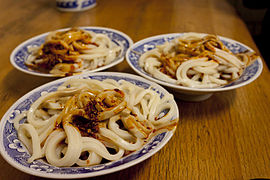Liangpi
This article needs additional citations for verification. (June 2019) |
| Liangpi | |||||||
|---|---|---|---|---|---|---|---|
 Liangpi | |||||||
| Chinese | 凉皮 | ||||||
| |||||||
Liangpi (simplified Chinese: 凉皮; traditional Chinese: 涼皮; pinyin: liángpí; lit. 'cold skin') is a noodle-like Chinese dish made from wheat or rice flour. It is a specialty dish originating from the cuisine of Shaanxi Province,[citation needed] but has now spread to many other places in China, in particular the northern and central regions. In northwestern areas of China, it is often called liangpi zi (凉皮子). Although liangpi is served cold, they are served in every season, including winter.
New York Times' Julia Moskin describes liangpi as served at Xi'an Famous Foods as "a dish of cold noodles in a sauce that hits every possible flavor category (sweet, tangy, savory, herbal, nutty and dozens of others)."[1]
Preparation
Liangpi literally means cold skin, although it contains no animal products. There are several ways of making liangpi:
First, wheat or rice flour is turned into a soft dough by adding water and a little bit of salt. Then, the dough is put in a bowl, water is added and the dough has to be "rinsed" until the water is saturated with starch from the dough, turning into a muddy white color. The remainder of the dough is now removed, and the bowl is left to rest overnight at a cool place to allow the dissolved starch to precipitate.
The following day, there will be a kind of starch-paste on the bottom of the bowl, with a more or less clear liquid on top, which has to be discarded. Once the liquid has been removed, a small amount of the paste can then be poured into a flat plate or tray, and spread evenly in a thin layer. The whole plate is placed into a large pot full of boiling water, where it is steamed for a couple of minutes, and the resulting "pancake" cut into long pieces vaguely resembling noodles.[2]
Types

Hanzhong Liangpi
Hanzhong Liangpi (simplified Chinese: 汉中凉皮; traditional Chinese: 漢中涼皮; pinyin: Hànzhōng liángpí) or Hanzhong Mianpi (simplified Chinese: 汉中面皮; traditional Chinese: 漢中面皮; pinyin: Hànzhōng miànpí), named for the city of Hanzhong in southwestern Shaanxi, are steamed liangpi with garlic and hot chili oil.[3] Unlike other places, it is often served hot rather than cold.[citation needed]
Majiang Liangpi

Majiang Liangpi (simplified Chinese: 麻酱凉皮; traditional Chinese: 麻醬涼皮; pinyin: Májiàng liángpí) are liangpi garnished with julienned cucumber and a sauce made of salt, vinegar, hot chili oil and especially Chinese sesame paste, for which it is named (simplified Chinese: 麻酱; traditional Chinese: 麻醬; pinyin: Májiàng).[4]
Shaanxi Gan Mianpi
Shaanxi Gan Mianpi (陕西岐山擀面皮 is another type of Liangpi, which tastes a bit firmer and looks darker in color compared to other Liangpi. The process of making Gan Mianpi is quite laborious, including several iterations to separate gluten and starch, by washing the dough in cold water a few times. After washing, mainly gluten is left in the dough, which can be solidified by boiling (called Mianjin). The starch water is thickened by boiling as well, and then spread on a pan and further cooked as a pancake.
It is always served with Mianjin (solidified gluten), cooked vinegar, hot chili oil, salt, mashed garlic in water and bean sprout.
See also
References
- ^ Moskin, Julia (30 July 2008). "Let the Meals Begin: Finding Beijing in Flushing". The New York Times.
- ^ "凉皮——详细制作过程教你做陕西风味小吃", meishichina.com, 23 July 2008.
- ^ "各具特色的陕西凉皮", meishichina.com, 6 March 2005.
- ^ Goldberg, Lina (22 February 2013). "Asia's 10 greatest street food cities". CNN Travel. Retrieved 24 February 2013.
